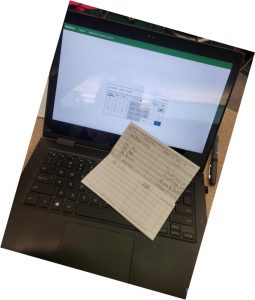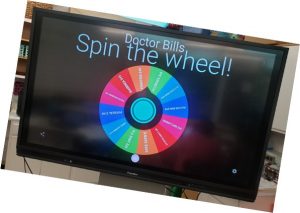We often rolled our eyes (literally) and stomped our feet (figuratively) when we looked at our pacing guide and saw the week that we would spend teaching account reconciliation. We viewed it as a necessary evil of eighth grade math state standards and as a concept that our students rarely see in action at home. Therefore, we begrudgingly took a week and taught a concept that was “freestanding.” “Hey kiddos, this week, we’re learning something that you haven’t seen before and will not see again until state testing!” There had to be a better way that leads to student growth and success, without taking an entire week of instruction. Can you think of a similar concept that could be better taught as a project, over a semester or two, rather than being squeezed in randomly during the school year?
Our reimagined approach to teaching account reconciliation began with a wild day of planning that including many “what ifs” and “we can do this!” Our purpose was to teach account reconciliation in a real-life context while exposing students to a firm dose of “reality.” We decided we needed a method to account for days students attended our class, a plan for imaginary compensation (we are teachers after all), reasons for incurring fictitious costs, and, finally, a method to record the information in a register format. The idea was coming together in a format that we thought might be as much fun as it was effective. We planned to pilot it during our second quarter focus activities, when this state standard was scheduled to be assessed.
We devised a method to account for the days our students attended class, which included tasking students with “clocking-in” daily. We purchased grid-lined poster boards from Amazon, and we began our project. Each class had its own poster board, and each student had their own line to keep track of their daily attendance. Not only did this method work for our project, but it was a quick and efficient way of taking attendance.

The rules were easy: each student would receive $10 per hour of school attended, or $70 per day. Every two weeks, we would have payday and PAY-day. Students would record transactions in check registers, that were donated by local banks. Their earnings would be based on the days they were in class, and they would have to spin a wheel (free online tool) to pay for any absences. An absence resulted in a charge of some type, debits to their accounts, for anything from $500 charges for discipline issues, x-rays for $600, a bad hair day for $100, or the dreaded foot fungus for $25. We also paid bonuses to students who stayed after school and had a “you never know what will happen” wheel, so all students got a chance to spin. These activities resulted in great conversation about the reality of making $10 per hour and costs that we all learn to face as adults.
Our project has become a favorite with our students, and they have learned about beginning balances, credits, debits, ending balances, and overdrafts. We put ourselves to the test by assessing their skills at reconciling accounts, without the benefit of our usual review, and the results were remarkable. We assessed using our focus activities, which is how we knew they understood the topic. For example, on “Writing and Balancing a Checkbook,” our prior year students scored 83%, 81%, and 82% on their focuses. After this new approach, our 2019-2020 students scored 96%, 97%, and 95%, without review or a full week of instruction.
 We realized that we could continue to learn and grow as teachers and lesson planners, with the most significant benefit coming in the form of student growth and success! Our students learned so much more than they ever would have given a week of account reconciliation lessons and practice, with the context, discussion, and experiences of looking at it briefly every other week for an entire semester. Our students learned the concepts, applied them to real-world discussions, and even took their newfound knowledge into other areas of their education. Who knows what our next project will be, but we know that we will keep this one going for years to come!
We realized that we could continue to learn and grow as teachers and lesson planners, with the most significant benefit coming in the form of student growth and success! Our students learned so much more than they ever would have given a week of account reconciliation lessons and practice, with the context, discussion, and experiences of looking at it briefly every other week for an entire semester. Our students learned the concepts, applied them to real-world discussions, and even took their newfound knowledge into other areas of their education. Who knows what our next project will be, but we know that we will keep this one going for years to come!

super cool and relevant!
This is a really interesting concept as students learn about handling money. This would be an interesting activity to use when teaching economics with a few tweaks here and there.
Wow! This article is so interesting and relevant for students! The idea of combining real-world application to assess and advance student understanding is wonderful. However, this approach took it a step further by creating an entirely new classroom culture that students truly bought into!
As I am studying to become a Secondary Social Studies educator, I feel like this would be a great project when teaching about finances in economics. The project is really engaging and students will learn a lot like how to manage money. Overall, I think that high school students will find this project to be both fun and educational.
I’m impressed by how this project made account reconciliation engaging and practical for students. By integrating real-life scenarios and hands-on activities, the teachers effectively improved student understanding and performance in a way that traditional teaching methods might not achieve.